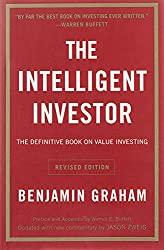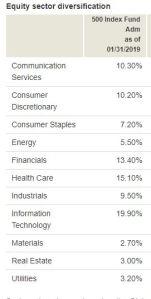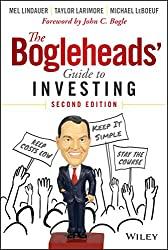
If you read a few personal finance and investing blogs, they’ll generally recommend that you invest in mutual funds for diversification. Diversification means to spread your money out to several different investments rather than just buying a few investments. The reason for this is two-fold:
- If you have a lot of money in one or two companies and something bad happens like a big lawsuit, fraud by a major officer, or if the company just misreads the markets and makes bad choices, you could have a substantial loss from which your portfolio may not recover even with time. Single stocks can and do go bankrupt and disappear from the markets.
- You always want to be invested in whatever is going up at the time. If you’re concentrated in one or two sectors of the market, you might miss out on a big rally in another sector. If you’re spread out into everything, you’ll almost always be seeing some advancement in some sector while others are taking a breather after a big run-up.
(Note, if you click on a link in this post and buy something from Amazon (even if you buy something different from where the link takes you), The Small Investor will receive a small commission from your purchase. As an Amazon Associate I earn from qualifying purchases. This costs you nothing extra and is the way that we at The Small Investor are repaid for our hard work, bringing you this great content. It is a win-win for both of us since it keeps great advice coming to you (for free) and helps put food on the table for us. If you don’t want to buy something from Amazon or buy a book, how about at least telling your friends and family about our website as a great place to learn about investing and personal finance. Thanks!)

Personal finance books and websites will also normally recommend index funds since the fees are lower than those found in traditional managed mutual funds. There is a good reason for index funds being cheaper: If you have a team of managers who are actively doing research and trading stocks and bonds in the fund to try to do better than the markets, it cost money to pay their salary and for the research and travel they do. If you buy an index fund, all the managers need to do is buy the stocks that are in the index at the ratios prescribed by the index. Easy peasy. No need to do a lot of research or hire a lot of highly compensated fund managers.
But there’s an issue with indexes. If you’re looking for diversification, meaning that you want to reduce your risk of bad things happening to single stocks by buying lots of different stocks and spreading your money out, indexes may not be providing the protection that you think they do. The reason is that indexes can and do get dominated by a few of the stocks in the index. Specifically, the stocks that have done well in the past which tend to make up an outsized portion of the index because they have done well. If you buy into an index and think that you’re spread out over 100 different stocks, you might be surprised to find out that most of your money is actually in just a few stocks.
(Note, if you click on a link in this post and buy something from Amazon (even if you buy something different from where the link takes you), The Small Investor will receive a small commission from your purchase. This costs you nothing extra and is the way that we at The Small Investor are repaid for our hard work, bringing you this great content. It is a win-win for both of us since it keeps great advice coming to you (for free) and helps put food on the table for us. If you don’t want to buy something from Amazon or buy a book, how about at least telling your friends and family about our website as a great place to learn about investing and personal finance. Thanks!)
Because the biggest positions in the index fund will tend to be the same stocks that have gone up in value a lot over the last several years, you will essentially be buying high. This is especially true if you buy into a growth index. This is because, once the stocks in an index are set with equal portions assigned to each stock in the index, as some stocks increase in value more than others, they become a bigger part of the index. If some stocks decline, they become a smaller portion. This means that if you buy into an index after it has been established for a while, you’ll be putting more money into stocks that have already gone up and are therefore more pricey and less into stocks that have gone down and are therefore better bargains. If you invest in a value index fund instead, following the advice provided by Benjamin Graham, Warren Buffett’s famous advisor and the author of the investing classic, The Intelligent Investor: The Definitive Book on Value Investing., you’ll avoid this issue somewhat. But still, you may be more concentrated than you think.

A look into the S&P 500 Index
To see this issue, let’s pull back the curtain on the S&P500 index, a very famous US large-cap index and one that many people buy as a core portion of their portfolio. The top 10 holdings in the Vanguard S&P500 Index Fund, as provided in the prospectus of the Vanguard S&P500 fund, are as follows:
Microsoft Corp.3.50%
Apple Inc.3.30%
Amazon.com Inc.3.10%
Alphabet Inc.3.00%
Facebook Inc.1.80%
Berkshire Hathaway Inc.1.80%
Johnson & Johnson1.60%
JPMorgan Chase & Co.1.50%
Exxon Mobil Corp.1.40%
UnitedHealth Group Inc.1.10%
So, while the S&P500 index has 508 stocks in it, 22% of the money you invest in an S&P500 fund will go into just 10 holdings. 12% will go into the top four holdings. This means that if Microsoft implodes, 3.5% of your portfolio will vaporize. Note that if I had written this article a few months ago, Apple would have been the biggest component in the list. Its shares have declined, however, showing just what can happen to an investor invested in one of these index funds.

SmallIvy Book of Investing: Book 1: Investing to Become Wealthy
Note also that the S&P 500 is somewhat tech-heavy, with the top five holdings al being internet or technology stocks. If the technology sector has a bad quarter, your S&P500 fund will likely have a bad quarter too. Looking at the full make-up of the S&P500 fund, we get the following:

As you can see, about 20% of the index is technology and 15% is healthcare. It is fairly light on basic materials and energy, which would mean that it wouldn’t protect the investor in times where inflation was picking up due to energy shortages like in the early 2000’s and the 1970’s as well as it would if the sector weightings were equal. Still, the index is fairly well balanced.
The NASDAQ index is not as good as the S&P500 when it comes to diversification. Here’s the top 5 stocks in the NASDAQ Q’s ETF:
MSFTMicrosoft Corp9.59%
AAPLApple Inc9.52%
AMZNAmazon.com Inc9.25%
FBFacebook Inc4.6%
GOOGAlphabet Inc4.57%
GOOGLAlphabet Inc4.01%
INTCIntel Corp3.03%
CSCOCisco Systems Inc2.89%
CMCSAComcast Corp2.22%
PEPPepsiCo Inc2.14%
Note that here Microsoft, Apple, and Amazon make up 30% of the index with each consuming about 10%. More than 50% of the index is composed of just five stocks. Looking at the top names, you also see a lot of repeats between the NASDAQ and the S&P 500. This is because the S&P500 is the big stocks, where the NASDAQ is the technology stocks. Because the biggest stocks over the last decade or two are technology stocks, you get a lot of duplication between these two lists. If you blindly bought the NASDAQ Q’s fund and an S&P 500 fund, thinking that you were diversifying well, you’d be in for a rude surprise when a bear market in the tech sector occurred.
So, what is the bottom line? If you’re seeking out diversification to protect your nest egg, blindly buying index funds may not be the way to go. You need to take a look under the hood a bit. Read the prospectus and see what the top holdings are and how big the positions are. See what percentage of the index are contained within the top five or ten holdings. Also, if you’re buying multiple funds for diversification, be sure that you aren’t getting all the same stocks in different funds.

Want to learn a lot more about stock investing?
If you want to go from being one of the crowd to a sophisticated investor, pick up a copy of SmallIvy Book of Investing: Book 1: Investing to Become Wealthy. In there I explain a lot more about things like growth and income investing. Having this kind of knowledge will help you get that extra edge you need to best your peers. There is also lots of material on how you should be managing your money at different stages of your life to grow your wealth. Please consider grabbing a copy and checking it out. I think you’ll be glad you did.
Have a burning investing question you’d like answered? Please send to [email protected] or leave in a comment.
Disclaimer: This blog is not meant to give financial planning or tax advice. It gives general information on investment strategy, picking stocks, and generally managing money to build wealth. It is not a solicitation to buy or sell stocks or any security. Financial planning advice should be sought from a certified financial planner, which the author is not. Tax advice should be sought from a CPA. All investments involve risk and the reader as urged to consider risks carefully and seek the advice of experts if needed before investing.
